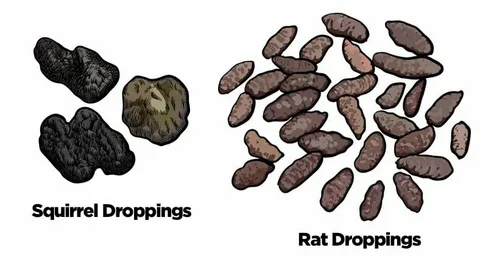When it comes to dealing with pests in your home, one of the key signs of an infestation is often the presence of droppings.
Whether it’s rats or squirrels, these droppings can reveal a lot about what kind of animal is causing trouble. But how can you tell the difference between squirrel droppings and rat droppings?
Understanding the distinctions is crucial for effective pest control and ensuring the health and safety of your home.
In this article, we’ll compare squirrel droppings and rat droppings, helping you identify which critter is leaving behind these signs.
What Are Squirrel Droppings?
Squirrel droppings are typically small, cylindrical, and resemble the size and shape of a raisin or a chocolate chip.
These droppings are often found in areas where squirrels are active, such as attics, lofts, crawl spaces, or near entry points where squirrels might have gained access to the building.
The general characteristics of squirrel droppings include:
- Size: Around 0.5 to 1 inch long (1.25 to 2.5 cm).
- Shape: Rounded at both ends and somewhat cylindrical in appearance.
- Texture: Soft but can harden over time, especially in dry conditions.
- Color: Dark brown to black, though fresh droppings may appear lighter in color before they dry.
- Consistency: They are moist when fresh but can dry out and crumble.
Squirrels are known to be relatively tidy animals, so their droppings are often found in clusters or in specific locations, such as nesting sites. Squirrel droppings also tend to be relatively clean and lack the strong, unpleasant odor associated with some other pests.
What Are Rat Droppings?
Rat droppings, on the other hand, are typically larger, more numerous, and shaped differently.
Rats are known to leave behind droppings in places where they travel frequently, including basements, kitchens, and areas around food sources.
The general characteristics of rat droppings include:
- Size: Around 0.75 to 1.5 inches (2 to 4 cm) in length.
- Shape: Pointed at both ends, resembling a small capsule or grain of rice.
- Texture: Smooth with sharp edges; they may also have a slightly greasy appearance due to their diet.
- Color: Dark brown to black, sometimes with a shiny or moist appearance if fresh.
- Consistency: Typically firm, but may soften if left undisturbed for a long time.
Rats are messier than squirrels, and their droppings are often found scattered in large numbers, indicating their frequent presence in a particular area. The droppings often accumulate along rat paths and near food or water sources.
Key Differences Between Squirrel Droppings and Rat Droppings
While both types of droppings can resemble each other at first glance, there are several key differences that can help you identify which pest is present in your home:
1. Size and Shape
- Squirrel Droppings: Smaller, typically cylindrical, and about the size of a raisin or chocolate chip. They are blunt at both ends.
- Rat Droppings: Larger, typically shaped like a capsule or grain of rice, with pointed ends.
2. Color and Freshness
- Squirrel Droppings: Dark brown to black, but they may appear lighter when fresh. The droppings dry out over time and lose moisture.
- Rat Droppings: Dark brown or black, but they often have a moist or shiny appearance when fresh.
3. Quantity and Distribution
- Squirrel Droppings: Often found in clusters near nesting sites or food sources. Squirrels are relatively clean and tend to leave droppings in specific areas.
- Rat Droppings: Rats tend to leave droppings scattered in large numbers throughout their habitat, often along trails or around food sources.
4. Texture
- Squirrel Droppings: Softer when fresh, but they harden as they dry.
- Rat Droppings: Firm, with sharp edges that can be more brittle than squirrel droppings.
5. Location
- Squirrel Droppings: Typically found in attics, lofts, or areas where squirrels are nesting. They often concentrate near entry points.
- Rat Droppings: Often found in basements, kitchens, garages, or other places where food is stored. Rats are more likely to be found in lower parts of the house.
Health Risks Associated with Droppings
Both squirrel and rat droppings pose health risks, and the need to address an infestation quickly cannot be overstated.
- Squirrel Droppings: Although squirrels are less likely to carry diseases that are transmitted directly through their droppings, their feces can still harbor bacteria, fungi, and parasites like roundworms. Handling or inhaling dust from dried droppings can lead to respiratory issues or allergic reactions.
- Rat Droppings: Rats are notorious for carrying a variety of diseases, many of which can be transmitted through their droppings, urine, or saliva. These diseases include Hantavirus, Salmonella, Leptospirosis, and Leptospirosis. Handling rat droppings without proper protection can lead to severe health issues, so it’s essential to take safety precautions.
How to Safely Clean Up Droppings
Regardless of whether you are dealing with squirrel or rat droppings, it is essential to wear gloves, a mask, and protective clothing when cleaning them up.
Avoid sweeping or vacuuming, as this can stir up harmful dust and pathogens. Instead, use a damp cloth or disposable wipes to carefully pick up the droppings and disinfect the area. It’s also wise to dispose of the droppings in a sealed bag.
Conclusion
Distinguishing between squirrel droppings and rat droppings is crucial for effective pest control.
While squirrels tend to leave behind small, cylindrical droppings in clusters, rats leave larger, capsule-shaped droppings scattered in large numbers.
Both types of droppings pose health risks, so it’s important to act quickly if you suspect an infestation. Whether you’re dealing with squirrels or rats, it’s best to consult with a pest control professional to ensure proper identification and remediation.



